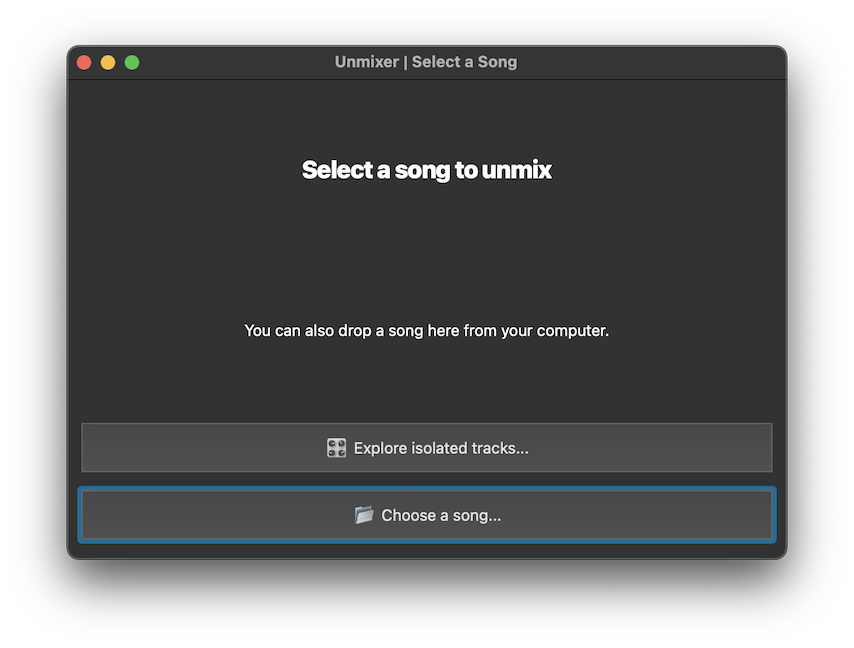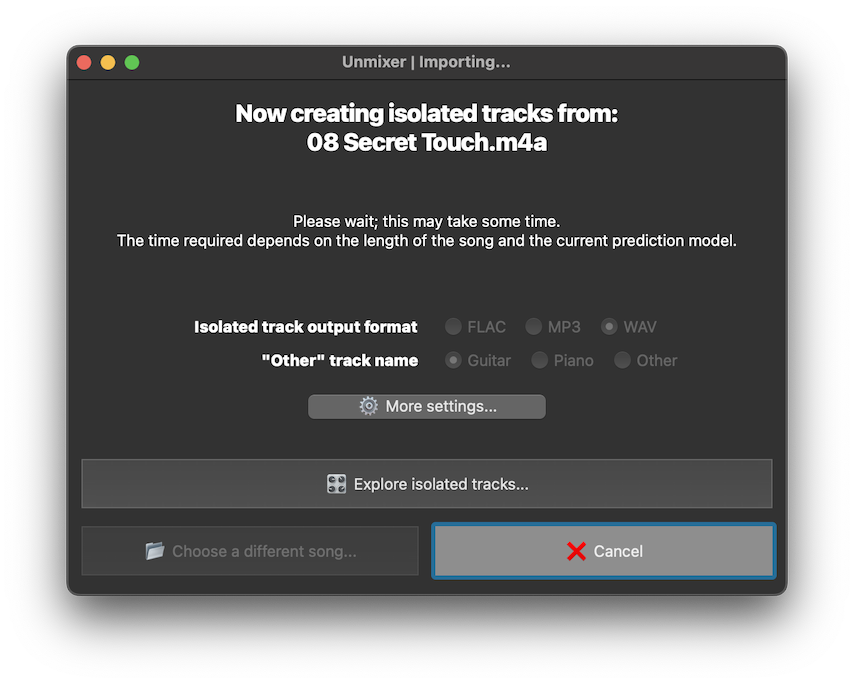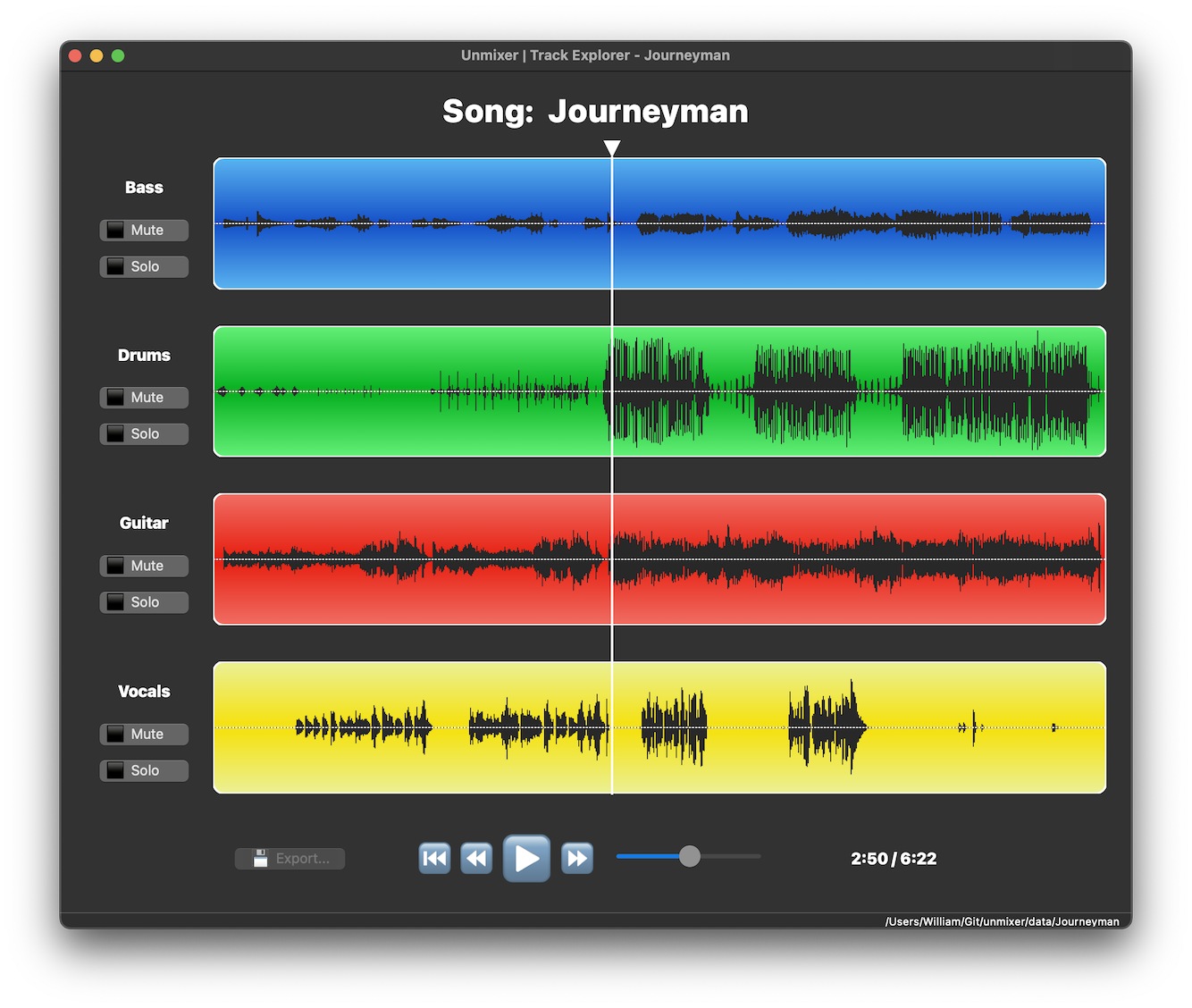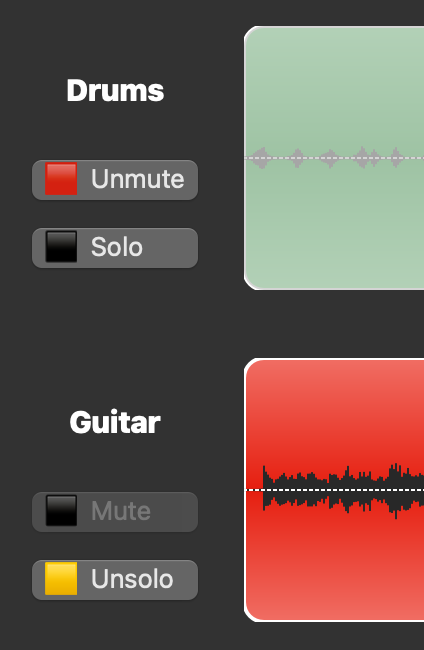Create and explore isolated tracks from music files
Project description
unmixer - create and explore isolated tracks from music files
unmixer is a graphical utility and Python package for creating isolated tracks
(drums, bass, vocals, etc.) from music files.
unmixer is a frontend for demucs,
an excellent command-line utility for music source separation from the
Meta Research team. The creation of isolated tracks
is handled entirely by demucs; unmixer provides a graphical interface for
viewing, playing, and exporting the isolated tracks in any combination.
Installation
The easiest way to install the package is to download it from PyPI using pip.
Note that unmixer depends on Python 3.11 or newer; please
ensure that you have a recent version of Python installed before proceeding.
Run the following command in a shell (Linux or macOS is assumed):
$ pip install unmixer
The package does depend on a few external Python packages available on PyPI. If you wish to sandbox your installation inside a virtual environment, you may choose to use virtualenvwrapper or a similar utility to do so.
When successfully installed, a program called unmixer will be placed on your PATH. See the
Usage section below for details about how to use this program.
Dependencies
- The utility expects
ffmpegto be installed for mixing isolated tracks. See the project's Downloads page for instructions on downloading and installingffmpeg.
Usage
The unmixer program is a graphical utility for exploring isolated tracks extracted
from a music file.
At any time, you can use the -h or --help flags to see a summary of options that
the program accepts.
$ unmixer -h
usage: unmixer [-h] [-o OUTPUT] [-g | -p] [music_file_or_track_dir]
create and explore isolated tracks from music files
positional arguments:
music_file_or_track_dir
path to the file to unmix, or path to a directory containing isolated tracks
options:
-h, --help show this help message and exit
-o OUTPUT, --output OUTPUT, --output-dir OUTPUT
path to the directory for output isolated tracks (default: ~/unmixer)
-g, --guitar show "Guitar" track instead of "Other"
-p, --piano show "Piano" track instead of "Other"
Creating Isolated Tracks
To create isolated tracks for a specific song, pass the path to the song to unmixer.
For example:
$ unmixer /path/to/Limelight.mp3
When invoked with no arguments, unmixer will open a window containing a button
labeled Choose... (see the screenshot below).
Click the Choose... button and select a music file that you want to create
isolated tracks from. The interface will change to reflect that the song is
being processed (see the screenshot below).
Please be patient during the process of creating the isolated tracks, as it will take some time to complete! It typically takes about as long as the source song itself (or a bit longer) to create the isolated tracks for a song. For example, if a song is 5 minutes long, it will likely take roughly 5 minutes to create isolated tracks for that song.
NOTE: Although unmixer does not display a progress bar in its graphical interface
showing the status of processing the song, the progress will be shown in the process's
standard output (assuming the standard output is not redirected to a file). Check the
shell or terminal from which you launched the unmixer UI to get a better approximation
of how long it will take to process the song. A visual progress bar may be added in
a future version.
Although it may be possible to speed up the process by adjusting the flags passed to
demucs, the current implementation tends to favor producing higher quality isolated
tracks at the expense of taking a bit longer. A future version of unmixer may allow
customizing the quality, output format, machine learning model, or other settings that
can be configured by demucs; the current version does not allow any such customization.
Output Tracks
The following isolated tracks are created by default:
bass.wavdrums.wavother.wavvocals.wav
These are the sources that are supported by demucs; unfortunately, there is currently
no specific source available for guitar, piano, or any others besides bass, drums, and
vocals. Any part of the song's audio that is not identified as bass, drums, or vocals
will be found in the other.wav file.
Customizing the "Other" Track Name
In some cases, the isolated track other.wav may contain primarily a single instrument,
such as a guitar or piano. In these cases, it may be useful for the resulting output track
to have a corresponding name such as guitar.wav or piano.wav instead of the default
other.wav.
To change the name of the "other" track to guitar.wav, the -g/--guitar flag may be
passed to unmixer. Similarly, to change the name of the "other" track to piano.wav,
the -p/--piano flag may be passed to unmixer instead. (It is an error to pass both
-g and -p at the same time.) It is not currently possible to customize the name of the
"other" track to be any arbitrary name, although this feature may be added in a future version.
Output Directory
By default, unmixer creates isolated tracks in subdirectories of the directory ~/unmixer.
Each song's isolated tracks will be placed in a new subdirectory of the output directory
named based on the song's filename. For example, isolated tracks for a song named
Subdivisions.mp3 would be placed in the directory ~/unmixer/Subdivisions by default
(note that the subdirectory does not include the .mp3 file extension).
NOTE: Creating isolated tracks for multiple songs with the same filename will result in any previous songs' isolated tracks being overwritten! If you need to process multiple distinct songs with the same filename, be sure to rename the created directories (or rename the song files themselves) to avoid conflicts!
Use the -o/--output/--output-dir flag to customize the output directory for isolated tracks
created by unmixer. A subdirectory of this directory will be created for the isolated tracks, as
described above.
Exploring Isolated Tracks
To explore isolated tracks located in a specific directory, pass the path to the directory to
unmixer. For example:
$ unmixer ~/unmixer/YYZ
NOTE: If you used unmixer to create isolated tracks for a song, the Track Explorer window
will open automatically when the song is finished processing. (Again...please be patient!)
The Track Explorer window displays the name of the song at the top, a set of playback controls at the bottom, and a waveform and a set of controls for each isolated track found in the input directory (see the screenshot below).
Playback Controls
Use the Play/Pause button found in the playback controls at the bottom of the Track Explorer
to control playback of the currently selected track(s). Click the Restart button to start playback
at the beginning of the song.
When the song is playing, you can drag the triangular playhead (displayed above the very topmost track, with a white line extending down over all of the waveforms) to skip to a specific part of the song. Dragging the playhead while the song is paused is not currently supported.
Track Controls
Each track has its own Mute button and Solo button displayed to the left of the track's
waveform. Use a track's Mute button to remove that track from the mix you hear when playing
the song. Inversely, use a track's Solo button to hear only that track when playing
the song. As the name implies, only one track may have the Solo button active at a time.
A track may not be both soloed and muted at the same time; soloing a muted track will unmute
the track automatically. Playback will pause automatically if all tracks are muted at the
same time.
Exporting a Custom Mix
Use the Export... button found in the playback controls at the bottom of the Track Explorer
to export the currently selected (i.e., unmuted) tracks as a new file. A dialog box will open,
allowing you to select a destination for the file and click Save. For example, to create an
instrumental mix of a song, mute the Vocals track and export the remaining tracks as a new mix.
NOTE: Exporting is disabled when only a single track is selected, since that single track is already a self-contained file that does not need to be re-exported. Similarly, exporting is also disabled when all tracks are selected, since the resulting mix is the same as the original song file that produced the isolated tracks in the first place.
If you export custom mixes in the same directory where the isolated tracks are located, the
custom mixes will also be loaded if you reopen the same directory using unmixer in the future.
If you want to avoid this, save any custom mixes to a different directory, such as a remixes
subdirectory of the directory where the isolated tracks are located.
Customizing the "Other" Track Name
In the same way as when creating isolated tracks (see above), the -g/--guitar flag may be
passed to unmixer to change the displayed name of the Other track (if present) to Guitar.
Similarly, to change the name of the Other track to Piano, the -p/--piano flag may be
passed to unmixer instead. (It is an error to pass both -g and -p at the same time.) It
is not currently possible to customize the name of the Other track to be any arbitrary name,
although this feature may be added in a future version.
Project details
Download files
Download the file for your platform. If you're not sure which to choose, learn more about installing packages.















